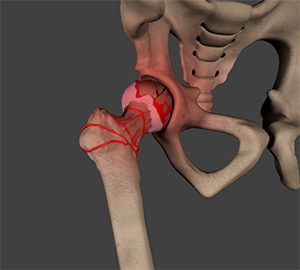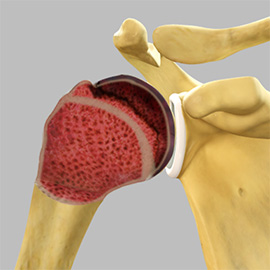Avascular Necrosis of the Hip
Avascular necrosis also called osteonecrosis, refers to a painful condition which results from lack of blood supply to bone tissue gradually leading to bone death, collapse of the bone, collapse of articular cartilage covering the bone and finally to disabling arthritis.
Blood flow to the bone may be adversely affected from damage to the blood vessels due to an injury, blockage by air or fat embolism in the blood vessels or by inflammation of the walls of the blood vessels. Injury to the bone is the main cause of avascular necrosis. Other possible causes include use of corticosteroid medications, excessive consumption of alcohol, and excess pressure inside the bone.


Symptoms
Though it can affect any bone, the ends of the thigh bone (femoral heads) are most commonly involved. Avascular necrosis does not show any symptoms in the initial stages of the disease but as it progresses, patients complain of pain and stiffness in the affected joint. Pain may be mild but can become worse at night or following physical activity. Sometimes pain may be so severe that range of motion of the joint will be restricted.
Non-surgical Treatment
Nonsurgical treatment involves the use of anti-inflammatory medications to relieve pain, blood thinning agents to reduce blood clots affecting blood flow, and cholesterol lowering agents to reduce fat deposition. Your doctor may advise to restrict activities and to use crutches to reduce weight bearing. Range of motion exercises may also be recommended. Stimulation with pulsed electromagnetic fields (PEMFs) or electrical current has been shown to be useful for enhancing bone repair and for exerting a chondro-protective effect on articular cartilage in the early stages of the disease and may also be recommended.
Non-surgical treatments usually relieve pain and delay the time until joint replacement becomes necessary. However, surgical treatment options are most successful especially when avascular necrosis is diagnosed in the very early stages prior to femoral head collapse.
Surgical Treatment
Core Decompression is the most commonly performed procedure for osteonecrosis in the last three decades. Core decompression is a minimally invasive procedure. It is safe and has low complication rates. Core decompression delays the need for total hip arthroplasty and does not change the anatomy to compromise THA. However, outcome of core decompression is better when avascular necrosis is in the initial stage that when the lesions are small and bone is in the pre-collapse stage. During core decompression, one large hole or several smaller holes are drilled into the inner core of the bone to reduce pressure inside the bone (intraosseous). This also reduces the edema and increases the blood flow by creating channels for new blood vessels to nourish the affected areas of the bone providing significant pain relief.






